No products in the cart
The Philips Avent bottles are a household name in the field of bottle feeding. Many mothers have bought the Avent Classic bottles in earlier stadim. Meanwhile, the classic line has been succeeded by the Natural line. A bottle line with which you combine breast and bottle feeding effortlessly. In this article we tell you everything you need to know about the new launch of the Phillips Avent bottle line.

In April 2023, we are launching a revolution in the feeding bottle segment through the Philips Avent bottle line. The Philips Avent bottle line was developed on the need of parents to be able to both combined bottle and breastfeed and prevent feeding problems such as colic, gas and reflux.
Therefore, the Philips Avent bottle line is a total solution of combining natural feeding and preventing feeding problems!
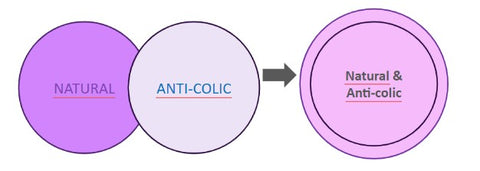
With the launch of the "Natural Response," Phillips offers a natural sucking reflex teat which merges the benefits of the combination natural and anti-colic. This total solution brings several advantages. We at Keekabuu mapped out the advantages of the Phillips natural sucking reflex teat over the Natural 2.0.
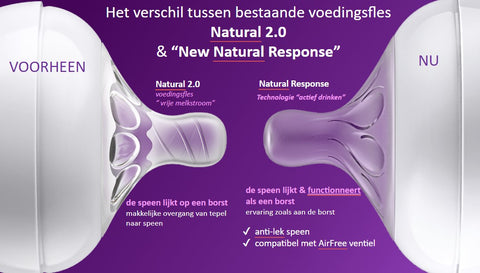
The first advantage of the Phillips natural suck reflex teat is that it has a natural response. With the Natural 2.0, the feeding bottle had a free flow of milk, while the natural suck reflex teat encourages the baby's active drinking. As a result, the baby will master the coordination of sucking, swallowing and breathing easier and faster.
Whereas the Natural 2.0 looked solely like a breast, Phillips' Natural Response feeding bottle also functions like a breast. This means that not only does the feeding bottle ease the transition from nipple to teat, but the teat also does not offer a free flow of milk and therefore does not leak during feeding. In addition, Phillips' Natural Response feeding bottle is also compatible with an AirFree valve.
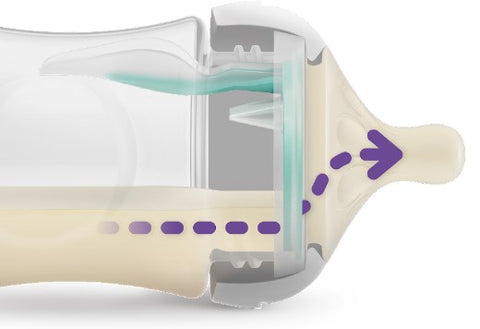
Up to 25% of children with normal developments may experience feeding problems. Phillips' natural sucking reflex teat still flows like feeding at the breast, but now it also helps reduce colic, gas and reflux. This has everything to do with the AirFree valve present on the Philips Avent bottle line. The AirFree valve allows direct feeding of a baby while the teat is full of milk. As a mother, this not only gives you a feeding bottle with teat and a natural sucking reflex, but also extra protection to prevent feeding problems!
Phillips' adaptive technology made it possible to bring this new Philips Avent bottle line to market. During the development of the new Phillips bottle line, the most important needs that parents have during the purchase of a feeding bottle were constantly considered.
Some of the main requirements of parents for a feeding bottle are: habituation to the bottle, how easy to clean, prevention of gas and cramps, a teat that forms on a breast.
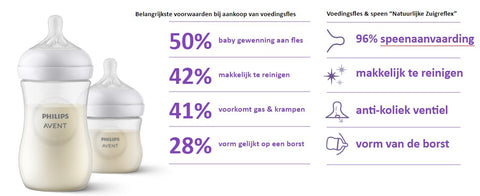
During the development of the new Philips Avent bottle line, careful consideration was given to a baby's suction and tongue pressure. The amount of suction & tongue pressure varies from baby to baby. Therefore, for flow rate, we looked at different types of babies to understand what flow rate each baby gets from a pacifier. Through this information, it is possible to develop the most ideal pacifier technology.

During the study, it became clear that babies who suck enthusiastically use a lower flow rate for a more relaxed & comfortable feeding. Babies who suckle slowly need a higher flow rate to drink the milk easily and at their own pace.
During the initial testing period of the Philips Avent bottle line, many inquiries were made about parents' experiences with Phillips' new teat technology. During this customer satisfaction survey, it became clear that the Philips Avent bottle line received excellent end-user ratings.
The table below shows which products from the Philips Avent bottle line received the best ratings.
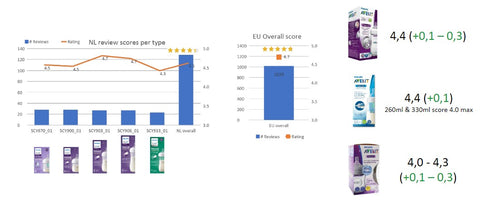
With the purchase of the new Phillips technology, it is good to consider the compatibility of the AirFree valve. This is because the AirFree valve is not compatible for use with all Phillips bottle-feeding products.
The AirFree valve is only compatible with the Philips Natural Response nipple or the Anti-colic nipple. The AirFree valve is not compatible with the Natural 2.0 teat, nor with the glass bottles.
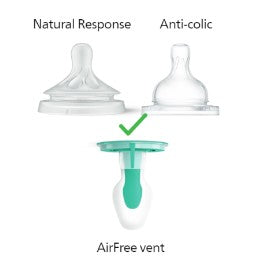
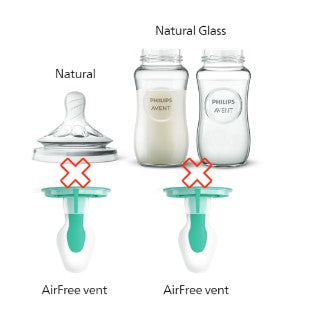
What is innovative about the Natural Suction Reflex teat?
Traditional teats flow as soon as you hold the bottle upside down, Natural Suck Reflex only flows when a baby applies suction just like breastfeeding.
What is the benefit of this for the baby?
They can better control the flow of milk and thus helps them feel more comfortable & calm during feeding.
What is the benefit of this for the mom?
There may be a time when you want / or need to bottle feed without giving up breastfeeding. This allows you to flexibly alternate with a product that mimics the mother's breast as precisely as possible. You can eliminate fears of so-called nipple confusion with this.
There is a 96% acceptance rate, does this mean they accept the pacifier right away on the first try?
No, it can take some time for the baby to get used to the pacifier. By warming the teat e.g. a little and staying constant in feeding with the Natural Sucking Reflex teat between feedings helps to build up and get them used to it. Patience is a virtue and practice makes perfect.
Why use an AirFree valve when there is already an anti-cramping system in the standard bottle?
The AirFree valve is designed to provide additional protection against feeding problems by preventing air from entering your little one's tummy during upright feeding.
When should I change teat feed rate?
The best way to decide teat replacement is to keep an eye on your baby's signals. The Natural Response teat is available in speeds 1 to 6. Enthusiastic drinkers usually need a lower-speed teat because they are likely to suck vigorously, resulting in greater milk release. Teat 6 is more suitable for thicker liquids or babies who want a high delivery rate.
On the other hand, slow and steady drinkers prefer a higher-speed teat because they usually want a lower delivery.
As long as your baby is calm and comfortable while feeding, there is no need to change the teat. You don't need to change the type of teat based on age. Your newborn's signals are the best way to tell when your baby is ready for a higher-speed pacifier.
When should I change the pacifier itself?
Replace the teat every 3 months for hygienic reasons. Inspect the teat regularly before each use. Pull the teat in different directions to check for damage. Do not use the teat and discard it if it is damaged.
What are the advantages of using a glass bottle instead of plastic?